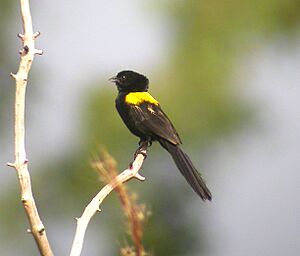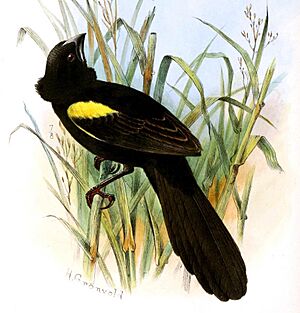Yellow-mantled widowbird facts for kids
Quick facts for kids Yellow-mantled widowbird |
|
|---|---|
 |
|
| Nominate race in the Central African Republic |
|
| Conservation status | |
| Scientific classification | |
| Genus: |
Euplectes
|
| Species: |
macroura
|
The yellow-mantled widowbird (Euplectes macroura) is a beautiful bird known for its bright colors. It belongs to the Ploceidae family, which includes many types of weaver birds. You can find these birds living in many parts of Africa. It is also sometimes called the yellow-backed widow.
Contents
About Its Name and Family
Scientists give every living thing a special two-part name, called a binomial name. This helps everyone know exactly which animal they are talking about. The yellow-mantled widowbird's scientific name is Euplectes macroura.
A German scientist named Johann Friedrich Gmelin first officially described this bird in 1789. He gave it the name Loxia macroura. He noted that he found it in a place called "Whydah," which is now Ouidah in Benin, Africa. The name macroura comes from ancient Greek words meaning "long-tailed."
Later, in 1829, an English scientist named William Swainson created the group (or genus) called Euplectes. The yellow-mantled widowbird is now one of 18 species in this group.
Different Types of Yellow-mantled Widowbirds
Just like people can have different features depending on where they live, some animals have slightly different types called subspecies. Here are the main subspecies of the yellow-mantled widowbird:
- E. m. macrocercus (Lichtenstein, MHC, 1823) – Found in Ethiopia, Uganda, and western Kenya.
- E. m. macroura (Gmelin, JF, 1789) – Found from Senegal and Gambia all the way to southern Sudan, southwestern Kenya, and south to Zambia, Malawi, Zimbabwe, and western Mozambique.
- E. m. conradsi (Berger, 1908) – Found on Ukerewe Island in Lake Victoria.
What Does It Look Like?
Male yellow-mantled widowbirds are bigger than females. During the breeding season, males look very striking! They grow long tails and have bright black and golden yellow feathers.
The color of their back (mantle) can be golden yellow. However, one type, E. m. macrocercus, has a black back instead. Even when they are not breeding, all male yellow-mantled widowbirds keep their bright yellow shoulders.
Where Does It Live?
The yellow-mantled widowbird lives in many parts of Africa. Its natural habitat (the place where it lives) is usually grassy areas that get wet or flooded during certain times of the year. These areas are often in warm, low-lying regions.
You can find these birds in many countries, including Angola, Benin, Burkina Faso, Burundi, Cameroon, Central African Republic, Chad, Republic of the Congo, Democratic Republic of the Congo, Ivory Coast, Gabon, Gambia, Ghana, Guinea, Guinea-Bissau, Liberia, Malawi, Mali, Mozambique, Niger, Nigeria, Senegal, Sierra Leone, Sudan, Tanzania, Togo, Zambia, and Zimbabwe. The special E. m. macrocercus type lives in Eritrea, Ethiopia, western Kenya, and Uganda.



